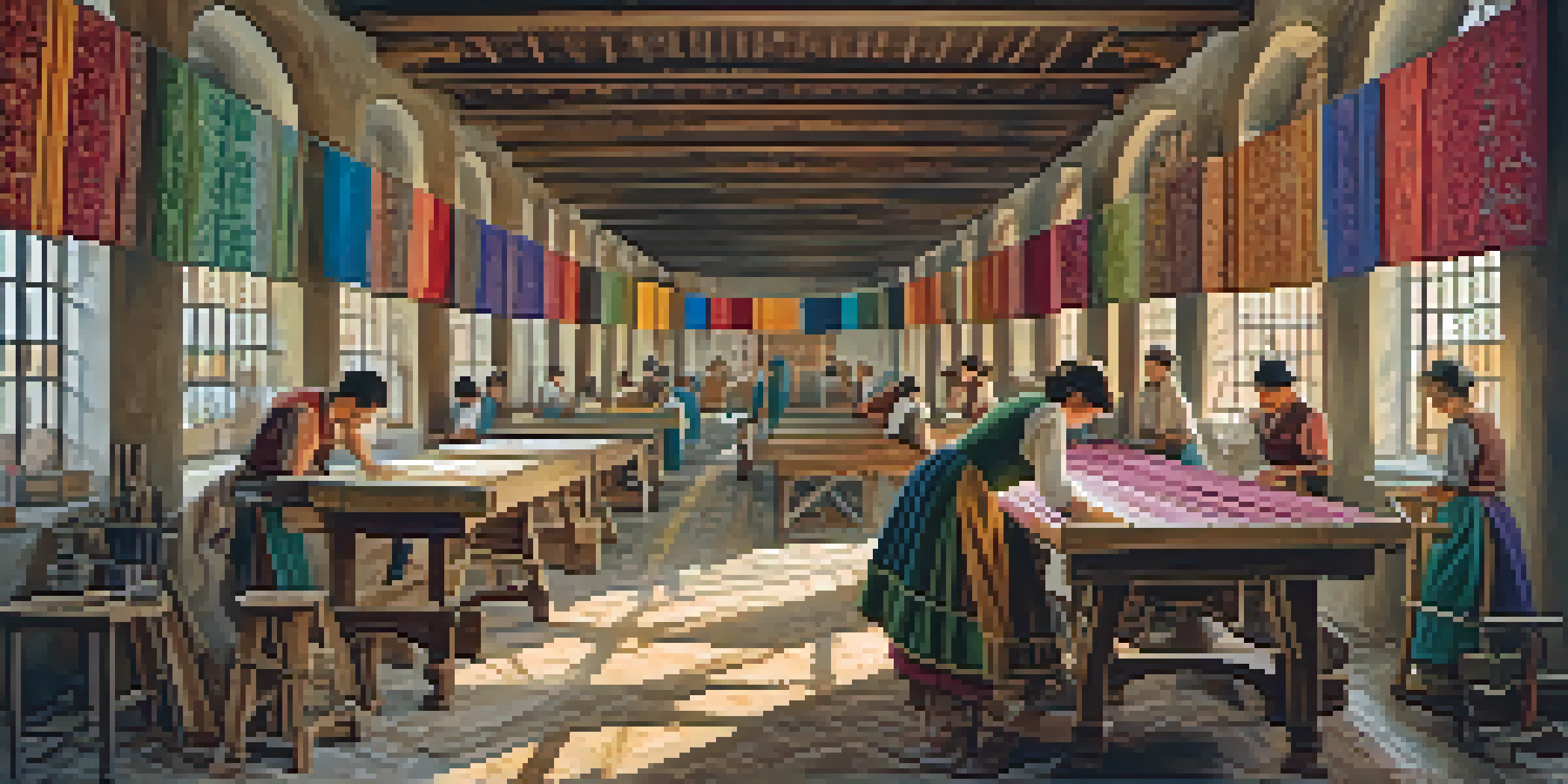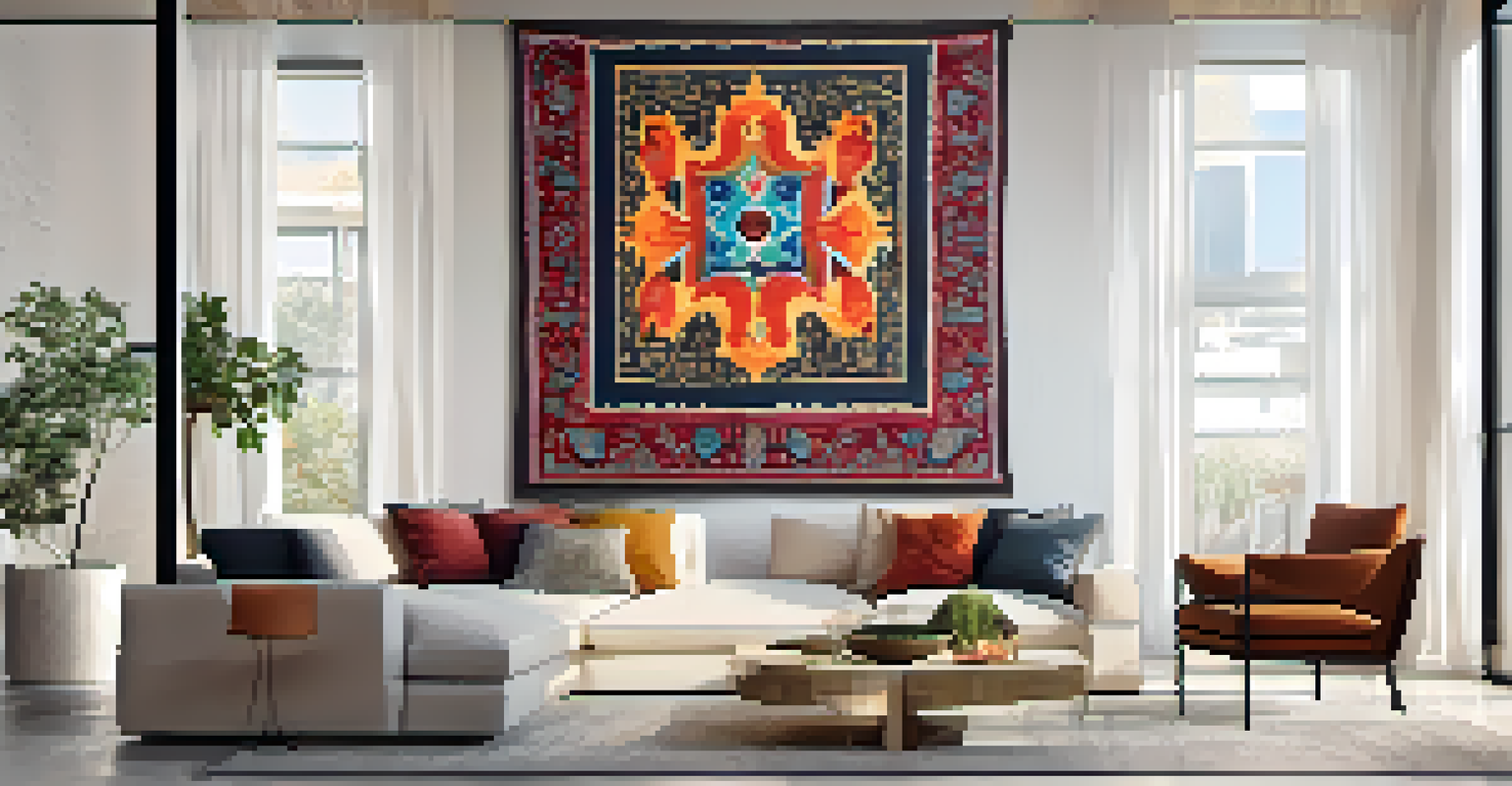Handwoven Textiles: The Art of Spanish Tapestry Making

The Rich History of Spanish Tapestry Weaving
Spanish tapestry making has roots that stretch back to the Middle Ages, showcasing a blend of cultural influences. This art form flourished particularly during the Renaissance, when Spain became a center for textile production. Tapestries were not just decorative; they told stories and reflected the social and political climate of the times.
Art is the most beautiful of all lies.
The tapestry workshops, especially in cities like Madrid and Barcelona, became renowned for their intricate designs and craftsmanship. These works often depicted religious themes, royal events, and scenes from everyday life, becoming cherished possessions of nobility and the church. Over the centuries, these pieces have preserved a wealth of historical narratives and artistic styles.
Today, Spanish tapestries continue to be celebrated, with artisans striving to keep the traditional techniques alive. The legacy of these textiles serves as a reminder of the country's rich cultural heritage and artistic innovation.
Understanding the Techniques of Tapestry Weaving
Tapestry weaving is a meticulous process that requires both skill and creativity. Weavers start by creating a design, known as a cartoon, which serves as a guide for the weaving process. Using a loom, they interlace colored threads to bring the design to life, working from the back to ensure precision in the final product.

The technique of 'weft-faced' weaving is often employed, meaning the weft threads (the horizontal ones) dominate the visual appearance of the tapestry. This allows for a rich texture and vibrant colors, enhancing the overall aesthetic. Each piece can take weeks, or even months, to complete, depending on its complexity.
Historical Roots of Tapestry Art
Spanish tapestry weaving dates back to the Middle Ages, flourishing during the Renaissance as a rich blend of cultural influences.
Artisans today still use many of the same techniques that have been passed down through generations. This dedication to craftsmanship is what makes each tapestry unique, as no two pieces can be replicated exactly.
Materials: The Heart of Tapestry Art
The choice of materials plays a crucial role in the quality and longevity of handwoven textiles. Traditional tapestries are often made from wool, silk, or a combination of both, each offering different textures and appearances. Wool provides durability and warmth, while silk adds a luxurious sheen to the finished piece.
Every artist was first an amateur.
Natural dyes, derived from plants and minerals, were historically used to achieve the rich colors associated with Spanish tapestries. This practice not only adds to the beauty of the work but also connects the art to the land and its resources. Modern weavers are increasingly embracing these traditional dyes, valuing sustainability and authenticity.
In addition to the fibers, the tools used in tapestry making are significant. The loom, shuttles, and combs each serve a purpose in the weaving process, and many artisans take pride in using handcrafted tools that have been passed down through their families.
The Role of Design in Tapestry Creation
Design is a vital aspect of tapestry making, as it influences the entire narrative of the piece. Historically, artists would collaborate with weavers, creating intricate designs that could be translated into woven art. This partnership between painter and weaver helped to ensure that the final tapestry captured the intended vision.
In modern times, designers often draw inspiration from traditional themes or contemporary art, marrying old with new. This evolution allows for a diverse range of tapestries that can fit various tastes and interior styles. From bold, abstract patterns to delicate representations of nature, the possibilities are endless.
Artisans Preserve Traditional Techniques
Contemporary Spanish weavers continue to utilize traditional weaving methods, ensuring that each tapestry remains unique and reflects a dedication to craftsmanship.
Moreover, the design process also considers the practical aspects of weaving. The artist must be aware of how colors interact and how the design will appear from a distance, ensuring that the final piece is visually striking both up close and far away.
Contemporary Spanish Tapestry Artists to Know
While the tradition of tapestry making has deep roots, many contemporary artists are breathing new life into this age-old craft. Artists like Royo and Manolo Valdés have gained recognition for their innovative approaches, blending traditional techniques with modern themes. Their work often challenges the boundaries of tapestry, exploring new narratives and aesthetics.
These artists not only create stunning tapestries but also engage in educational efforts to promote the craft. Workshops and exhibitions allow them to share their skills and passion with a broader audience, inspiring the next generation of weavers. This commitment to education is crucial for preserving the art form.
Their contributions signify a vibrant tapestry scene in Spain today, where the past and present intertwine to create unique pieces of art that resonate with contemporary viewers.
The Impact of Tapestry on Spanish Culture
Tapestry holds a significant place in Spanish culture and history. It has been used to adorn churches, palaces, and homes, serving both functional and decorative purposes. The rich visual narratives woven into these textiles provide insights into the cultural values and historical events of Spain's past.
In many ways, tapestries are a form of storytelling, capturing the essence of Spanish life and heritage. They reflect themes of faith, family, and national pride, making them an important part of cultural identity. This connection to the past is something that resonates with both locals and visitors alike.
Cultural Significance of Tapestries
Tapestries serve as vital expressions of Spanish culture, capturing historical narratives and themes of faith, family, and national pride.
Furthermore, the revival of interest in traditional crafts has sparked a renewed appreciation for tapestry art. Events like exhibitions and craft fairs showcase the beauty and significance of these textiles, encouraging a continued dialogue about their role in contemporary society.
How to Care for Handwoven Tapestries
Caring for handwoven tapestries is essential to preserve their beauty and longevity. Regular dusting is recommended to prevent dirt and debris from building up, which can damage the fibers over time. Using a soft brush or a vacuum with a gentle attachment can help keep the tapestry looking fresh.
Additionally, it’s important to avoid direct sunlight, as UV rays can fade colors and weaken the materials. If possible, hang tapestries in areas with indirect light to protect them from damage. When it comes to cleaning, professional cleaning services that specialize in textiles are often the best option.

Lastly, storing tapestries properly can also enhance their lifespan. Rolling them with acid-free tissue paper and keeping them in a cool, dry place helps to prevent creasing and deterioration. With proper care, these beautiful works of art can be cherished for generations.